Influence of Partial Arc on Electric Field Distribution of Insulator Strings for Electrified Railway Catenary
Abstract
:1. Introduction
2. Simulation Model
2.1. Calculation Principle
2.2. Establishment of Calculation Model
3. Electric Field Distribution of Insulator Strings without Partial Arc
3.1. Electric Field Distribution of Insulator String under Clean and Dry Conditions
3.2. Electric Field Distribution of Insulator String under Contaminated and Wet Conditions
4. Electric Field and Potential Distribution of Insulator Strings after Partial Arc Occurrence
4.1. Partial Arc Setting
- (1)
- The arc was approximately a cylinder with a hemispherical dome on its head.
- (2)
- Considering a single arc condition, the partial arc extended forward along the surface of the insulator string.
- (3)
- The trajectory of the partial arc was in the same plane as the central axis of the insulator string.
- (4)
- The partial arc occurred from the high-voltage end.
4.2. Electric Field Distribution of Partial Arc Extension on Insulator String Surface
4.3. Electric Field Distribution of Partial Arc Bridge Sheds of Insulator String
5. Conclusions
- (1)
- The appearance of a contaminated wet layer weakened the field intensity at the high-voltage and ground ends, and the U-shaped distribution of electric field was disrupted. The overall electric field distribution was flatter than that under the clean and dry conditions. The relationship between the electric field distribution and the shape of insulators was also obvious. The electric field intensity and the current density at the high-voltage end (No. 1 insulator steel pin) were the highest, and the partial arc was apt to occur at the high-voltage end.
- (2)
- The occurrence of a partial arc caused obvious distortion of the electric field, which was a two-dimensional axis symmetrical field before arcing to a three-dimensional field. In the case of arc extension, the sudden rise of field intensity was mostly at the rib and the shed edge. The rib and the shed edge performed a certain hindrance to the extension of the arc. In the case of arc extension, the electric field intensity of both the arc head and the insulator surface did not exceed that of air breakdown. The main reason for promoting the development of the arc can be attributed to thermal ionization. Setting the rib near the insulator’s high-voltage end and increasing the number of sheds are helpful in hindering the development of the arc.
- (3)
- In the case of arc bridge sheds, there appeared a distinct local maximum field intensity at the edge of the bridged shed. The maximum field intensity appeared at the edge of the last bridged shed. As the number of sheds arc bridged increased, the maximum field intensity also increased. As the arc length increased, the electric field intensity of the arc head also increased, which resulted in an accelerated arc development. The main factor to promote the development of the arc can be attributed to electrical breakdown. In view of the problem that the arc development speed is too fast after the arc bridges sheds, the insulators with different diameter sheds can be used, and a booster shed can be attached to the top of the insulator string to increase the difficulty of the arc bridging sheds, thereby reducing the occurrence of flashover.
- (4)
- Different factors have different influences on the electric field. Considering the influence of different arc starting positions, multiple partial arcs, different arc shapes and paths, different conductivities of the contaminated layer, dry zone, and environment around the insulator string on the electric field characteristics, this paper will focus on more influencing factors in future research.
Author Contributions
Funding
Conflicts of Interest
References
- China Railway Corporation. The Technology of High-speed Railway Catenary; China Railway Press: Beijing, China, 2014; pp. 1–6. [Google Scholar]
- Zhang, Z.; You, J.; Wei, D.; Jiang, X.; Zhang, D. Investigations on AC pollution flashover performance of insulator string under different non-uniform pollution conditions. IET Gener. Transm. Distrib. 2016, 10, 437–443. [Google Scholar] [CrossRef]
- Xu, J.; Yin, F.; Li, L.; Wen, Q.; Wang, H.; Liu, S.; Jia, Z.; Farzaneh, M. Wet Snow Flashover Characteristics of 500-kV AC Insulator Strings with Different Arrangements. Appl. Sci. 2019, 9, 930. [Google Scholar] [CrossRef]
- Jiang, X.; Wang, Q.; Zhang, Z.; Hu, J.; Hu, Q.; Zhu, C. Ion migration in the process of water freezing under alternating electric field and its impact on insulator flashover. Energies 2017, 10, 61. [Google Scholar] [CrossRef]
- Yu, W. Overhead Contact System of High Speed Electrified Railway; Southwest Jiaotong University Press: Chengdu, China, 2003; pp. 193–196. [Google Scholar]
- Zhao, S.; Zhang, Y.; Yao, X.; Wang, S.; Liu, J.; Zhang, W. Modeling and Simulation of Electric Field Distribution of Cantilever Insulators for Catenary. J. Rail. 2017, 39, 59–66. [Google Scholar]
- M’hamdi, B.; Teguar, M.; Mekhaldi, A. Optimal design of corona ring on HV composite insulator using PSO approach with dynamic population size. IEEE Trans. Dielectr. Electr. Insul. 2016, 23, 1048–1057. [Google Scholar] [CrossRef]
- Yin, F.; Jiang, X.; Farzaneh, M. Electrical performance of composite insulators under icing conditions. IEEE Trans. Dielectr. Electr. Insul. 2014, 21, 2584–2593. [Google Scholar] [CrossRef]
- Zhang, Y.; Zhao, S.; Chen, Z. Influence of Suspended Sand Particles on Potential and Electric Field Distribution Along Long Rod Insulator. High Volt. Eng. 2014, 40, 2706–2713. [Google Scholar]
- Wang, H.; Wang, S.; Deng, C.; Yang, G.; Lv, F. Study on the flashover characteristics of bird droppings along 110kV composite insulator. In Proceedings of the 2018 International Conference on Power System Technology (POWERCON), Guangzhou, China, 6–8 November 2018; pp. 2929–2933. [Google Scholar]
- Skopec, A.; Wankowicz, J.G.; Sikorski, B. Electric field calculation for an axially-symmetric insulator with surface contamination. IEEE Trans. Dielectr. Electr. Insul. 1994, 1, 332–339. [Google Scholar] [CrossRef]
- Bo, L.; Gorur, R.S. Modeling flashover of AC outdoor insulators under contaminated conditions with dry band formation and arcing. IEEE Trans. Dielectr. Electr. Insul. 2012, 19, 1037–1043. [Google Scholar] [CrossRef]
- Xu, Z.; Lu, F.; Li, H. Influence of Separated Globules on Post Insulator Electric Field Distribution. High Volt. Eng. 2010, 2278–2284. [Google Scholar]
- Gu, L.; Zhang, J.; Sun, C. Influence of surface electric field distribution along polluted cylindrical insulator on flashover process. Process 1993, 13, 70–76. (In Chinese) [Google Scholar]
- Sima, W. Study on Electric Field Distribution and Flashover Mechanism of Polluted Suspension Insulator Surface. Ph.D. Thesis, Chongqing University, Chongqing, China, 1 July 1994. [Google Scholar]
- Ale-Emran, S.; Farzaneh, M. Flashover performance of ice-covered post insulators with booster sheds using experiments and partial arc modelling. IEEE Trans. Dielectr. Electr. Insul. 2016, 23, 979–986. [Google Scholar] [CrossRef]
- Zhang, Z. Study on Pollution Flashover Performance and DC Discharge Model of Insulator (Long) Strings at Low Air Pressure. Ph.D. Thesis, Chongqing University, Chongqing, China, 1 October 2007. [Google Scholar]
- Xu, Z.; Lu, F.; Li, H. Influencing Factors of Insulator Electric Field Analysis by Finite Element Method and its Optimization. High Volt. Eng. 2011, 37, 944–951. [Google Scholar]
- Yu, X. Practical Technical Guide of Electrified Railway Catenary; China Railway Press: Beijing, China, 2011; pp. 269–315. (In Chinese) [Google Scholar]
- IEC 60305:1995. Insulators for Overhead Lines with a Nominal Voltage Above 1000V-Ceramic or Glass Insulator Units for A.C. Systems-Characteristics of Insulator Units of the Cap and Pin Type; International Electrotechnical Commission: Worcester, MA, USA, 1995. [Google Scholar]
- Xu, Z.; Lu, F. Influence of insulating materials and their parameters on surface electric field strength and potential distribution of insulators. Power Syst. Tech. 2011, 32, 152–157. [Google Scholar]
- GB/T 1402-2010 Railway Applications Supply Voltages of Traction Systems; China Standard Press: Beijing, China, 2010. (In Chinese)
- Xu, Z.; Lu, F.; Li, H. Influence of Dry Band on Electric Field Distribution of Polluted Post Insulator. High Volt. Eng. 2011, 37, 276–283. [Google Scholar]
- Wang, L.; Li, X.; Cao, B.; Guo, C. Influence of Partial Arc on Leakage Current and Surface Conductivity of Insulators. High Volt. Eng. 2019, 45, 1624–1629. [Google Scholar]
- Zhang, R.; Guan, Z.; Xue, J.; Shuang, M. Conductivity of Partial Surface—A New Method to Describe Contaminated Degree of Insulator. High Volt. Eng. 1990, 22–28. [Google Scholar]
- Tang, Q. Contamination characteristics and electric field distribution of high voltage insulators. Master’s Thesis, Suzhou University, Suzhou, China, 1 May 2017. [Google Scholar]
- IEC 60507:2013. Artificial Pollution Tests on High-Voltage Insulators to Be Used on a.c. Systems; International Electrotechnical Commission: Worcester, MA, USA, 2013. [Google Scholar]
- Wilkins, R.; Al-Baghdadi, A. Arc propagation along an electrolyte surface. Proc. Inst. Electr. Eng. 1971, 118, 1886–1892. [Google Scholar] [CrossRef]

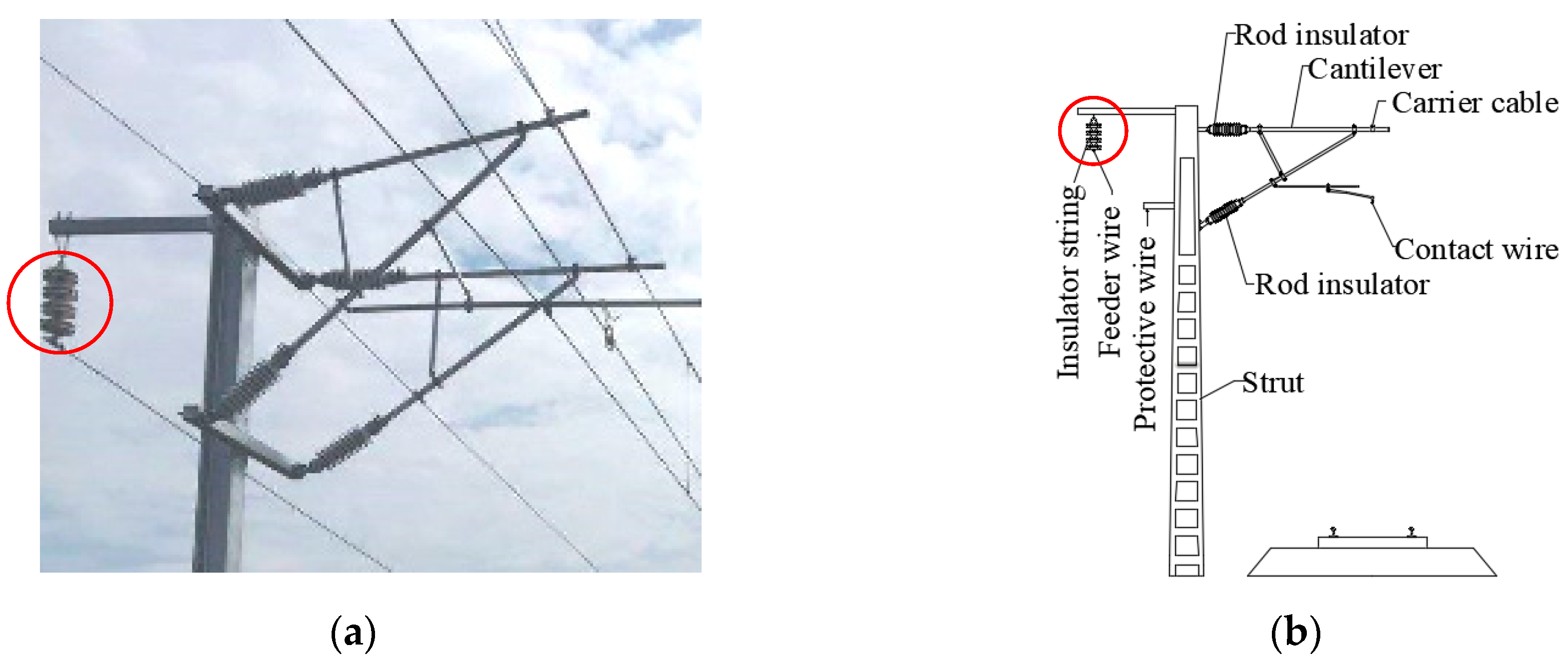
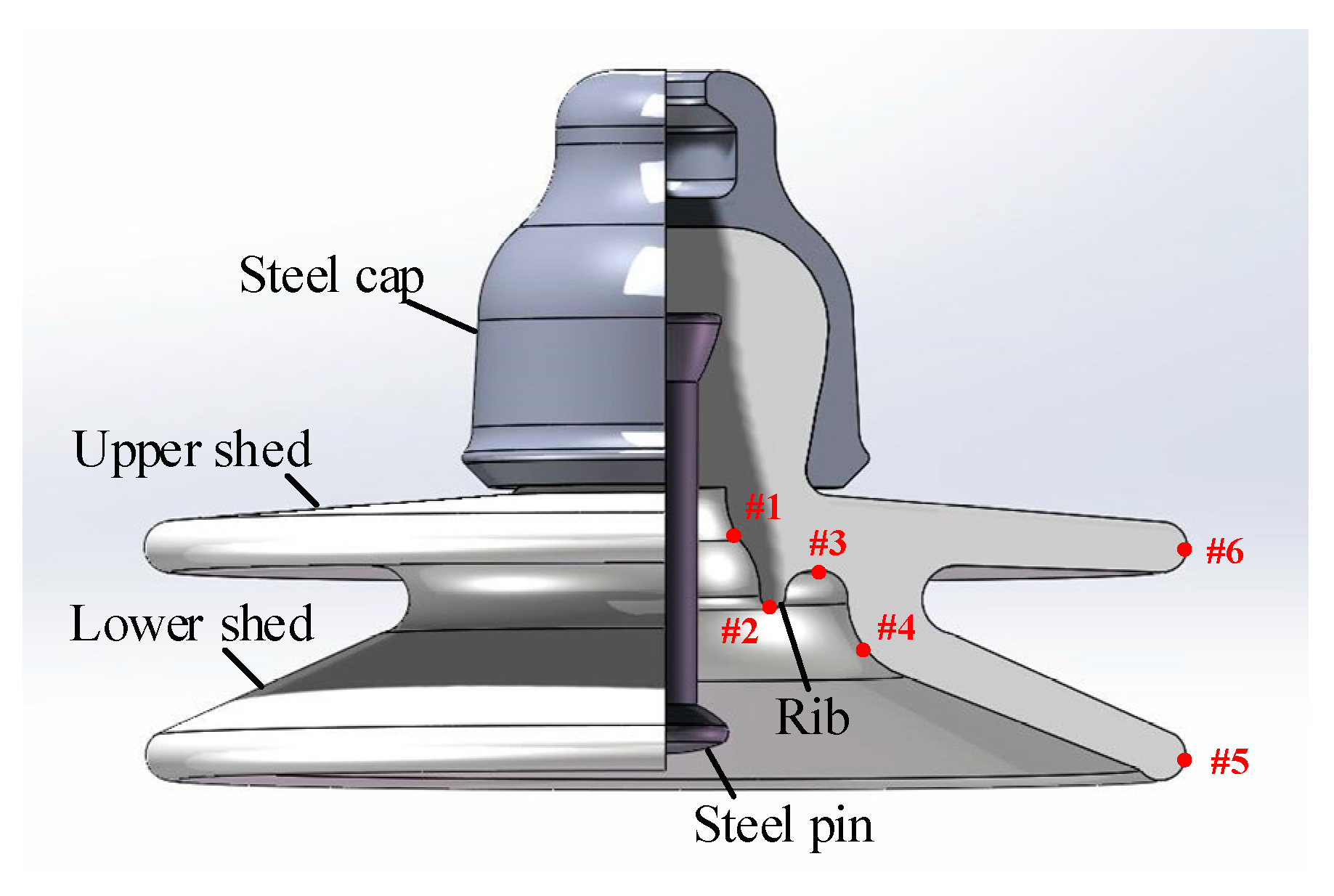

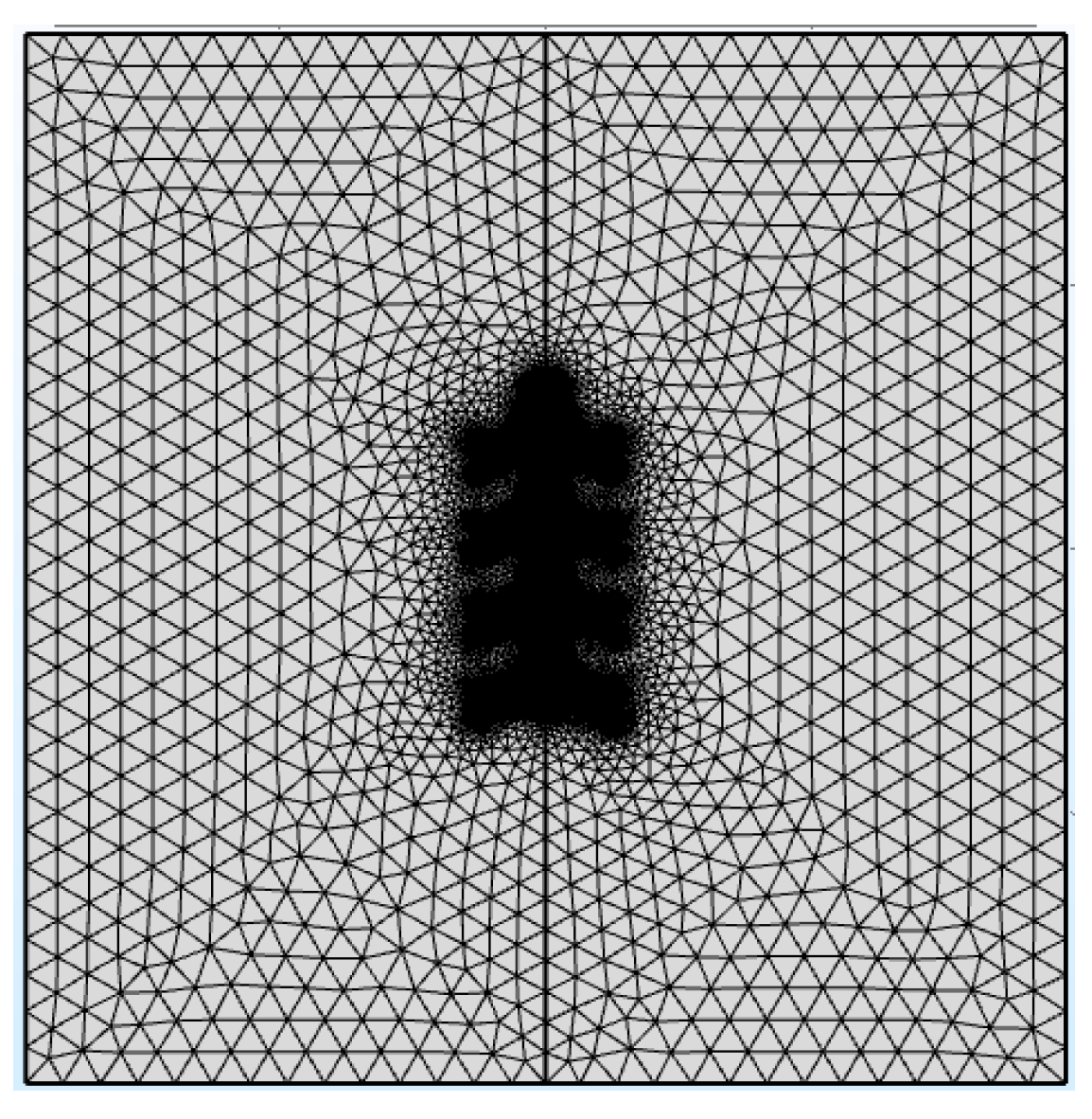
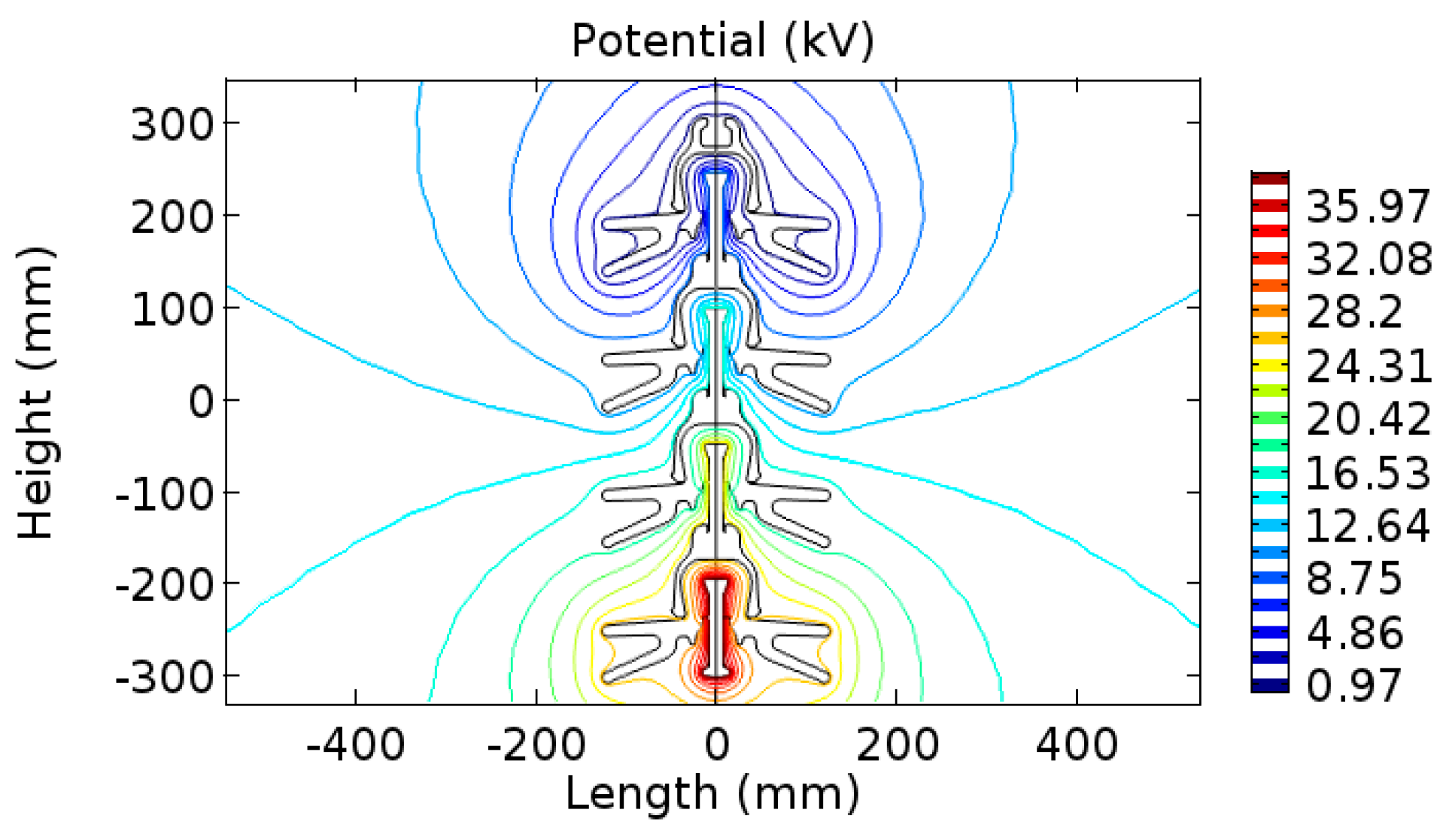

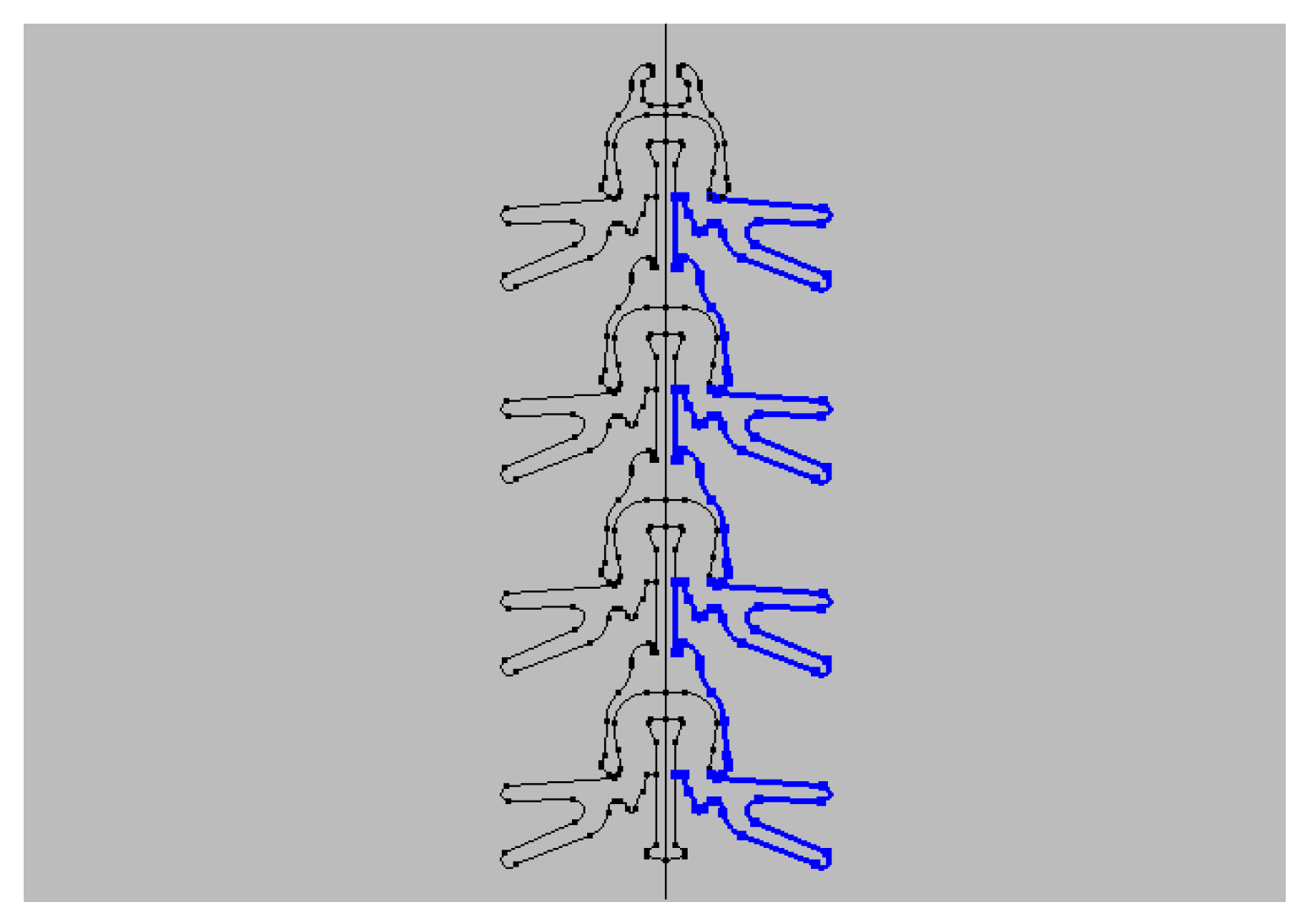


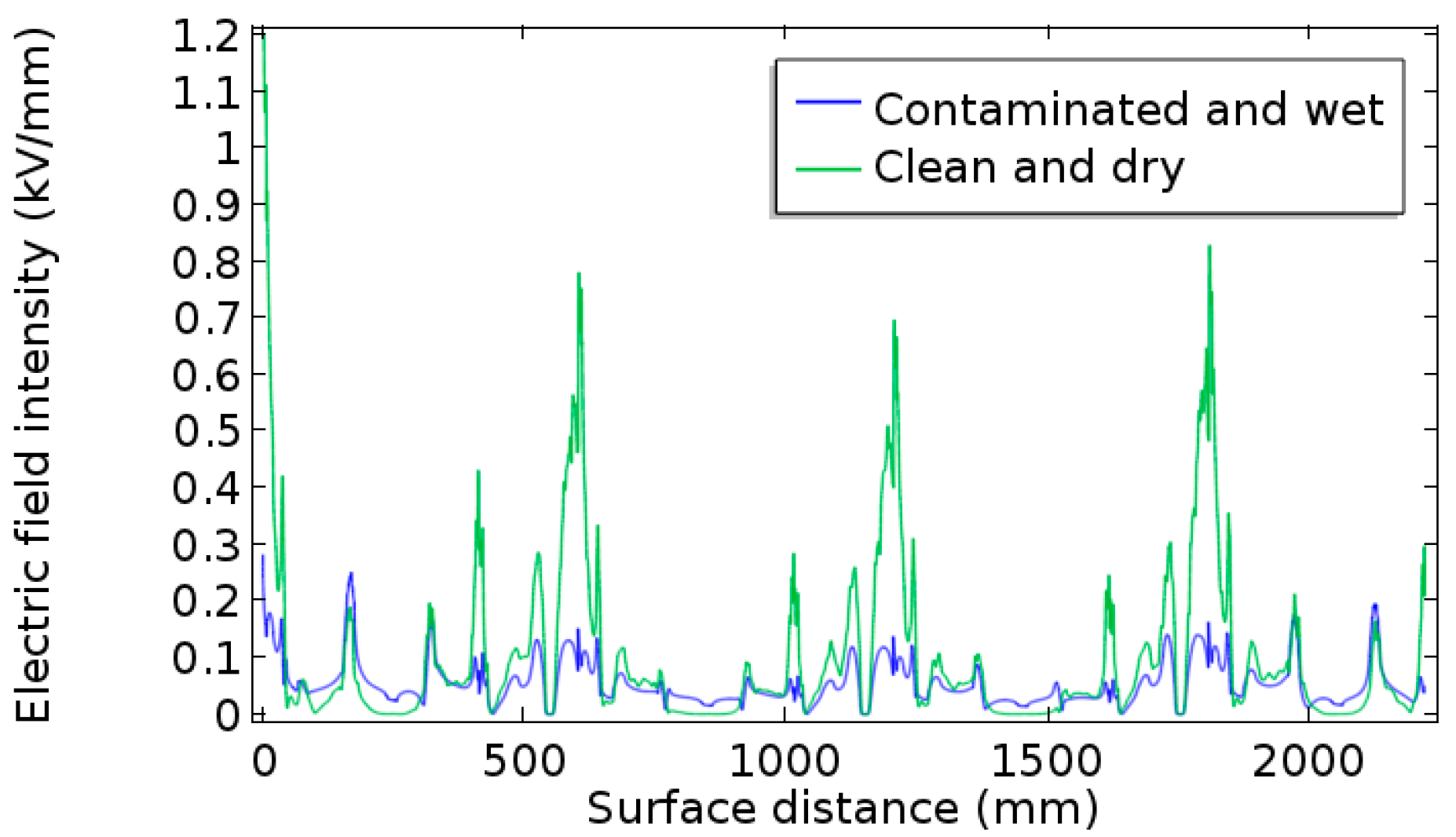

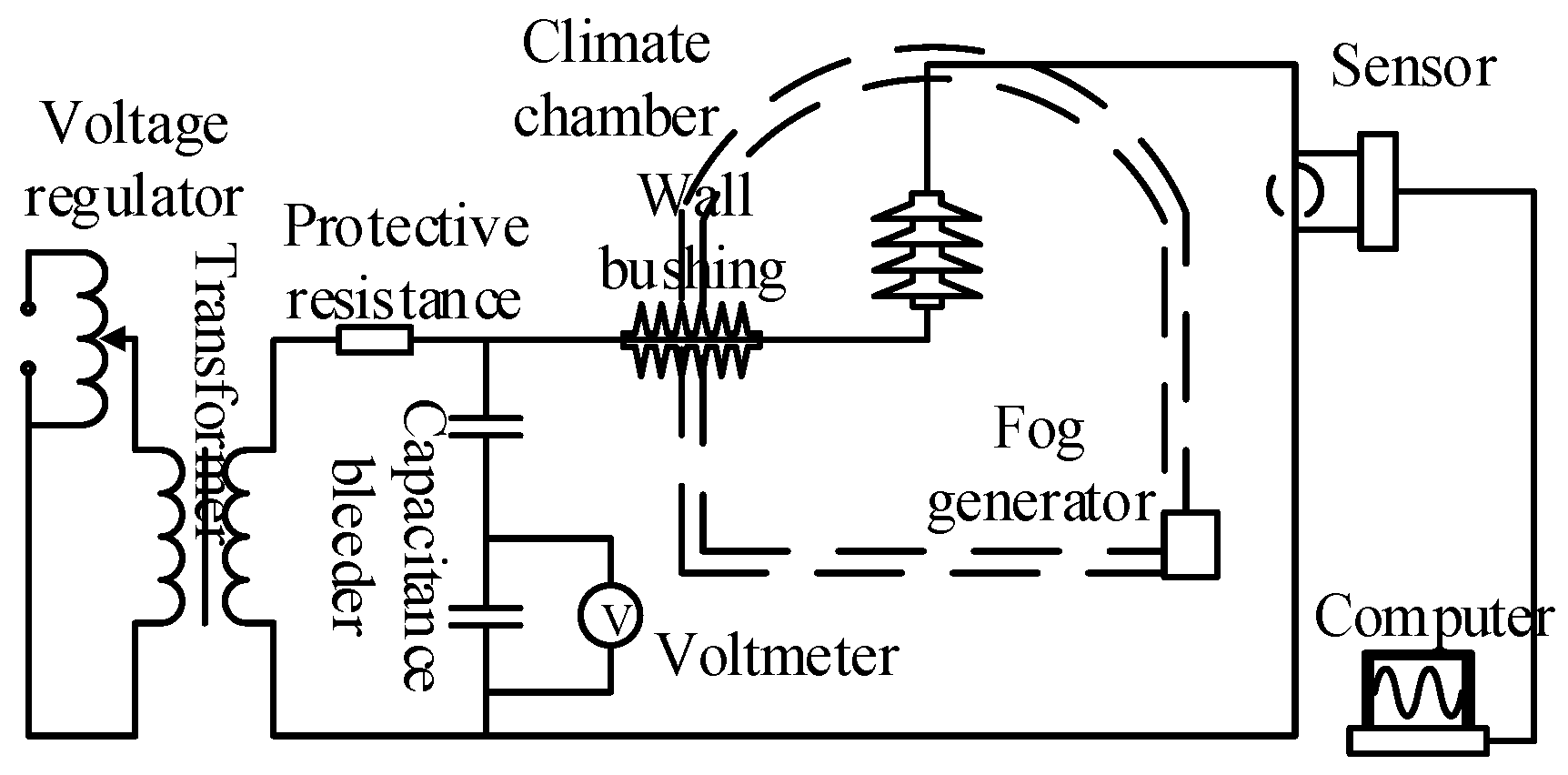
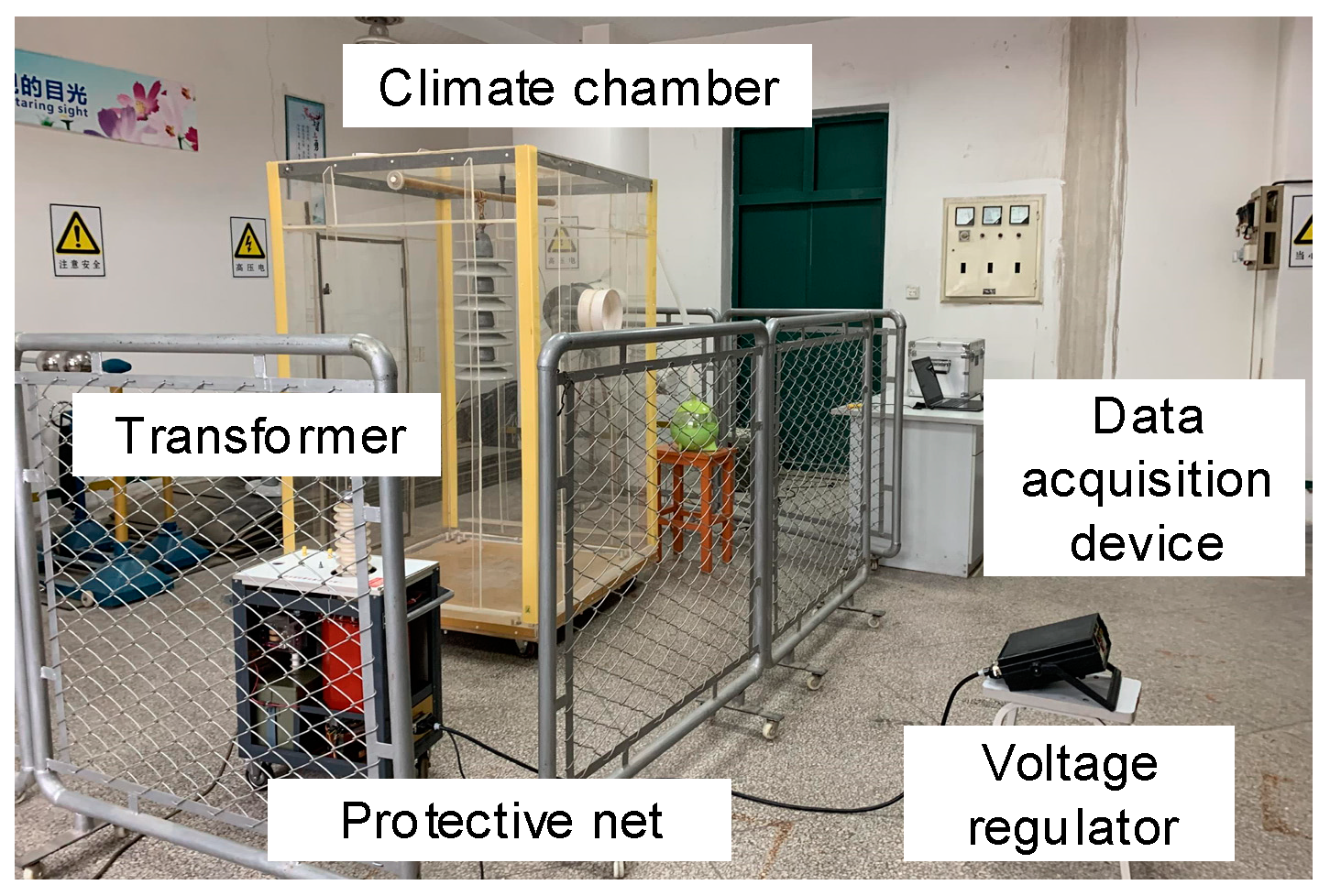
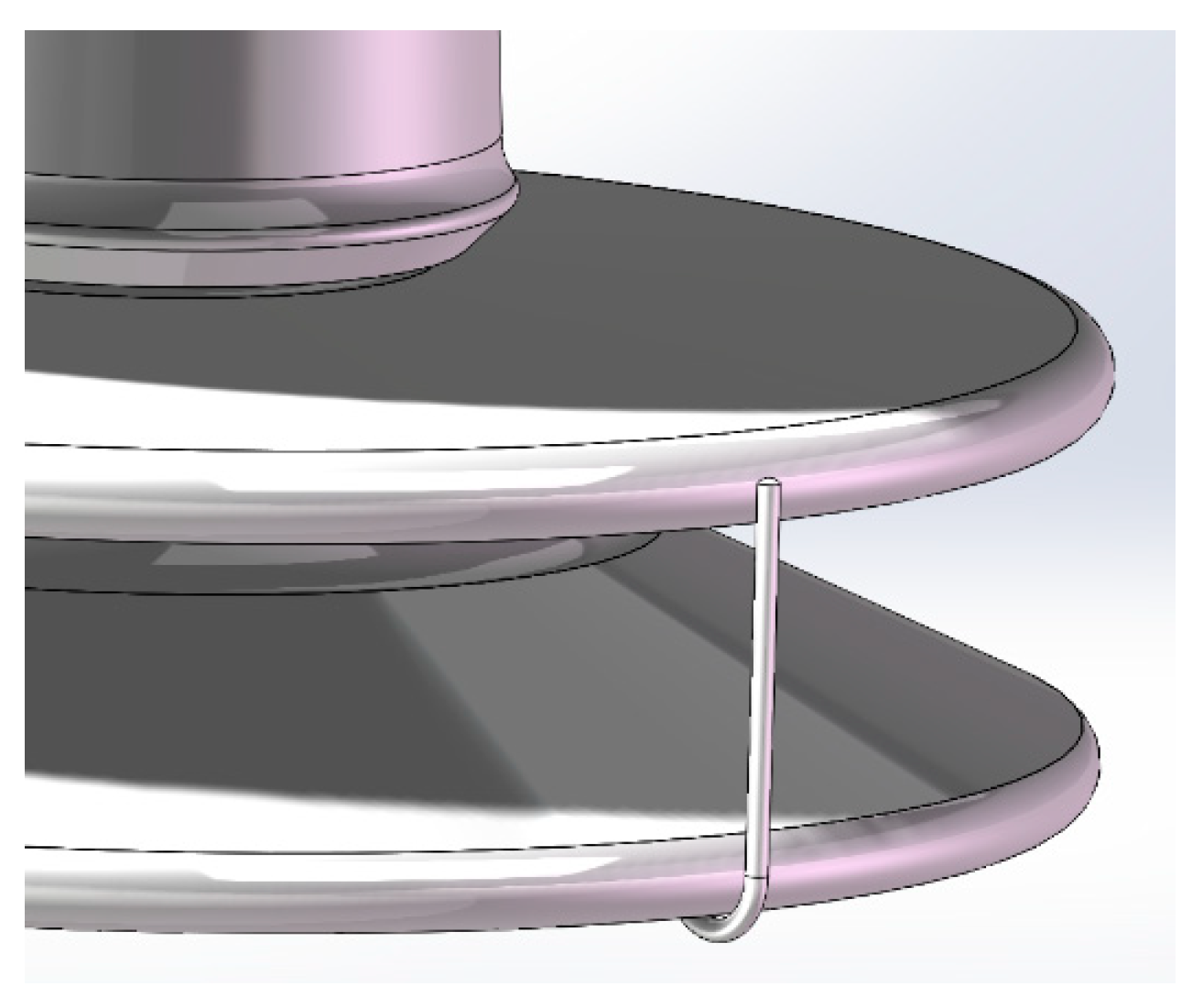









| Project | Mechanical Failure Load (kN) | Nominal Diameter (mm) | Nominal Structure Height (mm) | Creepage Distance (mm) |
|---|---|---|---|---|
| Parameters | 70 | 255 | 146 | 413 |
| Material | Air | Hardware Fittings | Porcelain |
|---|---|---|---|
| Relative Dielectric Constant εr | 1 | 1010 | 6 |
| Conductivity γ/(S·m−1) | 10−15 | 1.15 × 107 | 10−10 |
| Component | Starting Point (mm) | Terminal Point (mm) |
|---|---|---|
| Insulating part of No.1 insulator | 0 | 413 |
| Fitting between No.1 insulator and No.2 insulator | 413 | 604 |
| Insulating part of No.2 insulator | 604 | 1017 |
| Fitting between No.2 insulator and No.3 insulator | 1017 | 1208 |
| Insulating part of No.3 insulator | 1208 | 1621 |
| Fitting between No.3 insulator and No.4 insulator | 1351 | 1812 |
| Insulating part of No.4 insulator | 1812 | 2225 |
© 2019 by the authors. Licensee MDPI, Basel, Switzerland. This article is an open access article distributed under the terms and conditions of the Creative Commons Attribution (CC BY) license (http://creativecommons.org/licenses/by/4.0/).
Share and Cite
Zhao, S.; Zhang, C.; Zhang, Y.; Wang, S. Influence of Partial Arc on Electric Field Distribution of Insulator Strings for Electrified Railway Catenary. Energies 2019, 12, 3295. https://doi.org/10.3390/en12173295
Zhao S, Zhang C, Zhang Y, Wang S. Influence of Partial Arc on Electric Field Distribution of Insulator Strings for Electrified Railway Catenary. Energies. 2019; 12(17):3295. https://doi.org/10.3390/en12173295
Chicago/Turabian StyleZhao, Shanpeng, Chenrui Zhang, Youpeng Zhang, and Sihua Wang. 2019. "Influence of Partial Arc on Electric Field Distribution of Insulator Strings for Electrified Railway Catenary" Energies 12, no. 17: 3295. https://doi.org/10.3390/en12173295
APA StyleZhao, S., Zhang, C., Zhang, Y., & Wang, S. (2019). Influence of Partial Arc on Electric Field Distribution of Insulator Strings for Electrified Railway Catenary. Energies, 12(17), 3295. https://doi.org/10.3390/en12173295





